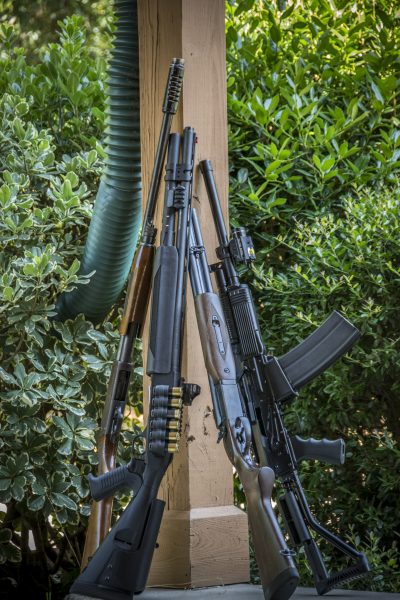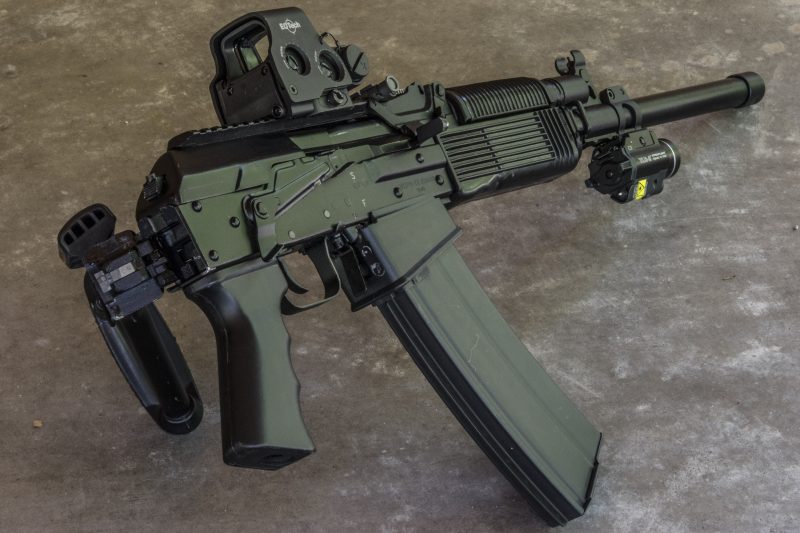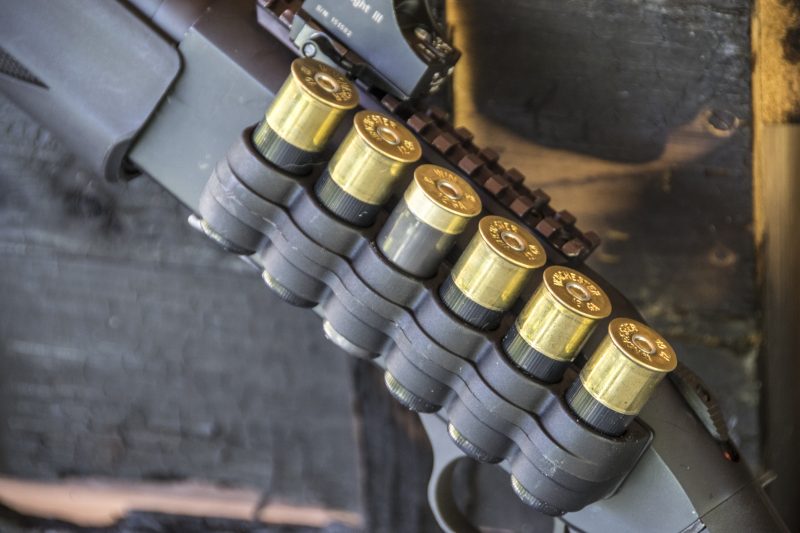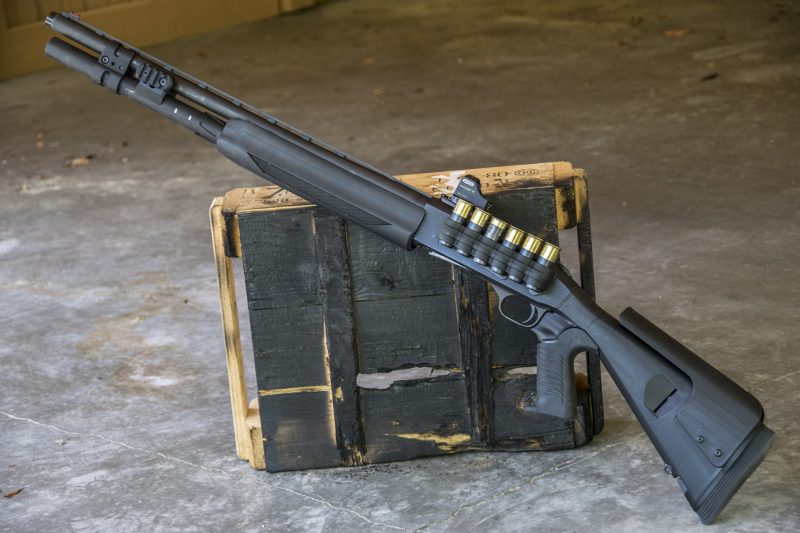7 Things to Know about Shotguns for Home Defense
Jim Grant 06.29.16

Professionals and laymen alike have lauded the shotgun as the ultimate home defense solution for decades. In the last few years that’s changed though, with increasing numbers of people ditching their old scatter guns in favor of modern, semi-automatic sporting rifles such as the AR-15.
The reasons for this exodus are varied, but mostly center on shortcomings that can either be mitigated to totally remedied with training, equipment or ammunition selection. That said, the shotgun is a remarkably effective tool for taking game and defending one’s home, so long as the shooter understands the intricacies behind doing so.
If you’re stuck trying to decide between a shotgun, pistol or rifle for home defense, read on. I’ve compiled seven considerations every shooter should know before buying home defense shotguns as well as some of the best shotguns for home defense.
- Scatterguns don’t.
One of the biggest misconceptions about shotguns is the extent of their spread. Yes, by definition a shotgun launches multiple projectiles from a single shell. But thanks to Hollywood and popular culture, most people imagine each shell launching a barrage of deadly pellets 5 feet wide at arm’s length.
Ask any three-gunner, clay shooter or bird hunter and they’ll tell you a very different story.
The diameter of the shot’s pattern is actually relatively small, especially at the ranges encountered in home defense scenarios. Even when fired from relatively short barrels, most pellets will land inside of a 5-inch circle at indoor ranges. Furthermore, the type of round used and choke employed also greatly affect pattern size.
This is important, because many novice shooters are under the assumption that shotguns don’t need to be aimed. They simply point in the general direction, pull the trigger and anything in this deadly radius is wiped out. The reality of shooting at small targets with a shotgun is very different; shooters need to carefully aim their firearm to ensure the maximum amount of rounds on target.

- Pump-action Shotguns Can Jam
This surprise hit me like a ton of bricks during a tactical shotgun course years ago. I was running a Mossberg 590 pump-action, ‘combat-ready’ shotgun during a brutal 10-hour course. After 350 rounds of full-power, double aught buckshot abusing my shoulder, the action began to bind.
Three boxes later, it ground to a halt.
No big deal though, right? Simply clean your preferred pump-action shotgun on a semi-regular basis and it will run without issue forever – at least if you know what you’re doing.
But what’s to know? The pump-action shotgun is beyond simple, so long as ammo is inside the magazine tube, working the pump will feed fresh rounds into the chamber ready to be fired. The one big bad dark secret about pump shotguns is they need to be pumped with vigor. Racking your shotgun one-handed like Schwarzenegger in “Terminator 2” is a surefire way to turn a reliable home defense tool into an unwieldy, expensive club.
Should shooters then abandon the pump-gun as a viable home defense weapon?
Absolutely not.
One of the greatest strengths of the pump-action shotgun is that it’s not ammunition sensitive. Meaning, shooters can run low-recoil defensive rounds through their firearm without worrying if the cartridge generates enough pressure to cycle the action. Because unlike semi-automatic shotguns, the pump-action utilizes human power to function.
This simply means that anyone looking to utilize a pump-action firearm of any sort should practice before loading it up and setting it beside their bed at night. Also, you can mitigate the cost of practice by using bird shot, but never use it for home defense purposes – which brings me to my next point.
- Birdshot Isn’t Defensive Ammunition
If this sounds obvious to you, take a moment to pat yourself on the back. Seriously. The amount of people I hear telling one another how they’ll just give their assailant a face full of bird shot to incapacitate them is astonishing.
Birdshot is named because it’s designed to pluck small flying animals from the sky, not incapacitate large, angry aggressive ones. While it might work in a pinch, birdshot has a terrible track record as a defensive round.
Think I’m wrong? I have verifiable proof of the round’s ineffectiveness against human beings.
When Harry Whittington was accidentally shot in the face at 30 yards by Vice President Dick Cheney, he survived – even after one of the pellets struck Whittington in the heart.
Think about that for a moment.
FBI ballisticians have advocated for decades that the most reliable way to incapacitate someone is to penetrate a vital organ like the brain or heart. The birdshot in Whittington’s case miraculously did this, but didn’t kill him. So if you do everything right and strike your assailant’s heart, there’s a real chance it won’t stop them – even if they’re a 79-year-old man like Whittington.
A better choice is 12-gauge, double-aught buckshot. This has long been considered the gold-standard for home defense and combat use for good reason. This load propels nine, 8.4mm lead pellets at roughly 1,200 fps. This load is like firing nine, .38 Special rounds into a target simultaneously. This is tremendously more effective at creating hydrostatic shock in soft tissue than super light steel birdshot.
- Recoil Doesn’t Have to Be Terrible
Shotguns are tremendously powerful, so it stands to reason that their recoil will be equally punishing to the shooter. While this is certainly true for bad combinations like featherweight guns and 3-inch magnum slugs, a properly fit shotgun with defensive ammunition is no worse than a full-powered rifle chambered in .308 Win.
The key phrase above is, “properly fit.”
The recoil of any firearm becomes exaggerated if it doesn’t fit the shooter well. Small-framed, female or younger shooters often have issues dealing with the substantial recoil of a shotgun primarily because it doesn’t fit them.
If after the shotgun is modified to suite a shooter, its kick still proves too much, there are other options to further reduce felt recoil. Products like limb saver pads, porting and even compensators or sound suppressors diminish the knock-back to more comfortable levels.
If you’re still not convinced, another method of mitigating the punishing bite of buckshot is to try different designs. Breech-loading, pump-action and any other manually-operating shotgun will produce more felt recoil simply because the human behind it absorbs all the rearward forces. Semi-automatic shotguns, on the other hand, produce far less felt recoil because a portion of the recoil’s energy is syphoned off to cycle the action. Which isn’t to say all semi-automatic shotguns are soft-shooting. Ask any Browning Auto 5 owner with an incorrectly installed friction ring or worn out recoil spring and they’ll show you a bruised shoulder.
Lastly, if after exhausting all the aforementioned options proves insufficient, picking a low-recoil defensive load can make all the difference for recoil-shy shooters. Just be certain to test the low-recoil ammo extensively if it will be used in a semi-automatic shotgun. Pump-gunners need only to run a full magazine of ammo to check patterning and positive feed.

- Reloading is More Difficult than Shooting
Every time I run a three-gun match I’m reminded of this fact. I’ll successfully clear a plate rack of targets, but drop a handful of shells trying to reload while running to the next stage. Professional shotgunners make it look as easy as throwing coins into an automated toll booth’s change basket, but make no mistake, it’s a hell of a lot harder than it looks.
Now this isn’t true for every shotgun, though. Shotguns such as the Saiga, Vepr 12 and the new DDI-12 that feed from detachable box-type magazines are a breeze to reload: simply insert a fresh magazine, charge the action and let it rip.
Magazine tube-fed shotguns, however, are vastly more difficult to reload – especially when under duress. One method used by competition shooters who run these shotguns is to continuously top off the mag tube whenever they expend rounds.

The only problem with this is it requires keeping multiple bulky shot-shells on your person, or in a shell carrier. The latter is ideal for homeowners who don’t sleep in pants with pockets. In either case, shooters should vigorously practice reloading their shotgun from whichever method they choose to build positive muscle memory.
- Two-handed Firearms Need Illumination
One of the five rules of firearms safety requires shooters to know their target and what’s beyond it. While the second half of that is fairly easy for home owners, as most people tend to know their own house, the first part is not.
Normally, most break-ins occur at night, so identifying the loud crash in your living room is next to impossible without some sort of illumination. This is important, because before pulling the trigger a responsible gun owner should know if they’re firing on their daughter’s boyfriend sneaking into the house at night, or a legitimate threat such as an armed intruder.
Additionally, if you’re running a weapon light on your shotgun without a tape switch, you run the risk of creating a beacon for bad guys to shoot at. So an external pressure switch is crucial for running a mounted light on home defense shotguns. There are currently too many on the market to name, but Mesa Tactical makes great stuff for traditional shotguns, and RS Regulate builds the best light mounts for Russian magazine-fed shotguns.
- Racking a Shotgun Won’t Scare Off Determined Attackers
Every time I hear a gun store owner repeat this one, I roll my eyes so hard it shifts the Earth’s axis. It’s not just because it’s simply wrong, but because it creates a very dangerous myth – one that could get an ignorant person killed, or gullible jurors to convict an innocent man.
Sound dramatic?
Read on.
For the sake of argument, let’s say charging the action on any firearm (pumping a shotgun, racking a slide, pulling on a charging handle, etc.) is somehow audible through the drywall of a home, and instantly recognizable to an intruder. The armed home owner has just done two things: they’ve broadcast their location to an intruder, and informed said intruder that they’re armed.
The second part sounds good, right? What sort of maniac would continue their intrusion against an armed adversary?
Oh, that’s right. Exactly the sort of people the home owner bought a gun to defend against in the first place.
I digress, so our armed home owner hears a terrifying crash of glass in the night, followed by hushed speaking and footsteps. The home owner steps out into the inky black hallways of his home and confidently racks the shotgun menacingly, confident that his would-be assailants will flee in terror.
What happens when the home invaders don’t leave?
Many people make the decision to buy a gun for defense, with zero intent of using it. This is a natural impulse; most people have no desire to kill anyone. The problem with this mentality is that you’ve just added a very dangerous element to the situation without the will to utilize it, against a foe who likely is.
Am I advising every gun owner to blitz any threat, guns blazing? No. Shooters looking to use any firearm for home defense must understand that using their firearm in defense of themselves and loved ones will very likely result in the death of the intruder. It won’t be glorious, fast or cool. It will likely be brutal, violent and horrifying – but not as bad as watching your wife and children suffer a worse fate.
If all this information seems grim or morbid, it should. The reality of home defense isn’t pretty, but can be necessary for you, and your family’s survival. With your life on the line, shooters shouldn’t have to worry about the difficulty reloading their gun in the dark, or whether their chosen round will actually stop a threat.

It may seem like I’m bashing shotguns as defensive tools, but I’m actually just pointing out the small shortcomings and special concerns shooters need to take into account before using a shotgun for home defense. Make no mistake, nothing else fired from the shoulder that’s legal for civilians to own is as effective at stopping threats in a single round then a 12-gauge shotgun.

